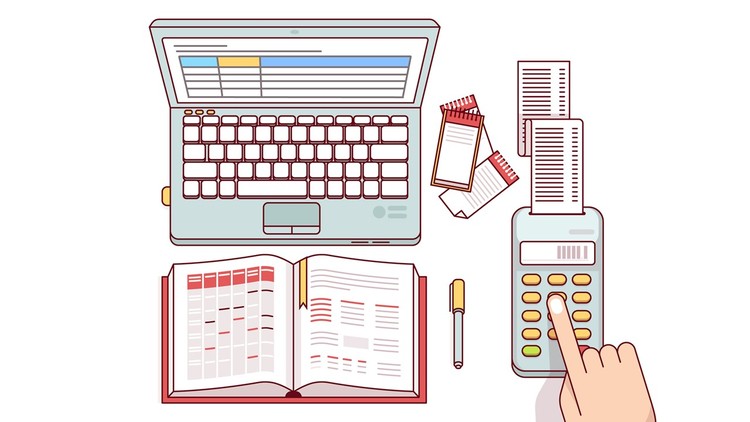Accounting, Bookkeeping, & Financial Statements: Zero to Pro

- Description
- Curriculum
- FAQ
- Reviews
Accounting, Bookkeeping, and Financial Statements Preparation are three steps to achieve one main goal, keeping a track of business money and prepare reports to provide a financial summary for stakeholders.
Why you should learn Accounting:
Every single business needs to record its income and expenses, not just for internal management and control, but also for external stakeholders like government, tax authorities, investors, lenders, and even suppliers and customers. Having a good command of numbers and the idea of how cash flows are recorded and presented makes you a better professional.
Who should take this course:
-
Accounting and Finance Students
-
Business Students
-
Aspiring Accountants
-
Professionals
-
Entrepreneurs
-
Business Owners
-
Investors
-
Startup founders
Prerequisite:
This course starts from zero, no background knowledge is required to start learning in this course. Even 12 years old can also learn Bookkeeping, Accounting, and Financial Statements Preparation in this course.
Money-Back Guarantee:
Nothing to lose! If you will not be satisfied with the course, Udemy offers 30 days money-back guarantee!
Topics Covered:
-
Introduction to Accounting
-
Why Accounting has to follow rules and what are the accounting standards?
-
What are the different types of Accounting and what information is produced by each?
-
Accounting terms
-
Cash and Accrual Accounting
-
Double-entry concept
-
Bookkeeping
-
General Ledger
-
Trial Balance and Financial Statements
-
Fixed Assets and Depreciation
-
Inventory Accounting
-
Financial Statements preparation
This built of the course is fairly easy, the format is beautifully designed interesting interactive video, the course flows from basis to Accounting to the preparation of financial statements first and then the more complex and frequently used areas of Accounting have been dealt with. This course also covers various practical concepts that are quite useful when you are maintaining your books in accounting software. In short, in the next 3 hours, you will be able to understand all the basic aspects of Accounting that you need to know to well handle your business financials.
Introduction to the teacher:
Chartered Accountant | 12 years of work experience | 12 years of teaching experience as visiting faculty
I am a Certified Chartered Accountant (ACCA) from the UK with 12 years of professional work and teaching experience and have taught more than 4,000 students in class and 40,000+ students on udemy!
I have implemented accounting software and ERP at various organizations and have expertise in financial transformation. I have been leading accountancy practice for small and medium-sized entities for the last 4 months and have frequent interaction with entrepreneurs. So I know what exactly do entrepreneurs need to know to well manage their books.
-
1Understanding AccountingVideo lesson
-
2Key classes and terms in AccountingVideo lesson
-
3Key Terms/classes in AccountingQuiz
Let's make sure you have properly understood the key terms in Accounting.
-
4Understanding Profit & Profit & Loss StatementVideo lesson
-
5Understanding Owner's Capital & Balance SheetVideo lesson
-
6Seperate Entity ConceptVideo lesson
-
7Understanding Dual Impact of a TransactionVideo lesson
-
8The Accounting EquationVideo lesson
The accounting equation is one of the fundamental concepts in Accounting. Let's take a brief look at this.
-
9Recording in AccountingVideo lesson
-
10Recording Debit and Credit for Assets - PracticeVideo lesson
-
11Debit and Credit rules for Liabilities, Owner's Capital, Income, & ExpensesVideo lesson
-
12Alternative way to understand and remember debit/credit rulesVideo lesson
-
13Double Entry Accounting/Bookkeeping with Debit & CreditsVideo lesson
-
14Debit & Credit PracticeVideo lesson
-
15Journal EntryVideo lesson
-
22Understanding and classifing AssetsVideo lesson
-
23Classifing Assets based on their physical substanceVideo lesson
-
24Understanding and classifing LiabilitiesVideo lesson
-
25The Formal Balance Sheet FormatVideo lesson
-
26Understanding and classifing IncomeVideo lesson
-
27Understanding and classifing ExpensesVideo lesson
-
28The Formal Profit & Loss Statement FormatVideo lesson
-
34Introduction and key termsVideo lesson
Before we start accounting for purchases and payables, let us learn some key terms that are related to it.
-
35Recording Cash Purchase and Purchase ReturnVideo lesson
Cash purchase is straight forward, let us quickly cover it in this lecture.
-
36Credit Purchase, payments, early payment discount, interest for late paymentVideo lesson
Credit purchase is itself a transaction, but as a result of credit purchase, later some other transactions also take place like payment, early payment discount, and the interest charge for late payment.
-
37ExampleVideo lesson
Let's get our hands dirty and record some accounting entries related to purchases and payables.
-
38Ledger posting and preperation of reportsVideo lesson
Example continued from last lecture.
-
39Purchases and Payables Accounting, May 2020Text lesson
-
40Introduction and key termsVideo lesson
Let's start by learning some key terms related to Sales and Receivables.
-
41Cash Sales and Sales ReturnVideo lesson
Cash Sales and cash sales return are part of daily business and these are easier to record. Let's take a look.
-
42Credit Sales and related transactionsVideo lesson
Credit Sale is one transaction, but it results in different other transactions taking place later. Let's take an overview.
-
43ExampleVideo lesson
Hands-on practice of sales and receivables entries.
-
44Example: Preparing ReportsVideo lesson
Example continues, preparation of reports.
-
45Important: Adjusting and Closing EntriesVideo lesson
In this lecture, we will pause our journey for a while and get our basics right. We will learn what are adjusting entries and what is adjusted trial balance.
-
46Recording transactions - JulyVideo lesson
-
47July Adjusting and Closing Entries, Adjusted Trial Balance, P&L, and B/SText lesson
-
48Allowance for Doubtful DebtsVideo lesson
Allowance for doubtful is a complicated area in Receivables Accounting, let's learn it from the basics.
-
49Allowance for Doubtful Debts - Accounting entiresVideo lesson
-
50Understanding terms: Goods, Purchases, Inventory/Stock, Cost of SalesVideo lesson
In Accounting, there are quite a few terms associated with goods. In this lecture, we are going to learn these terms.
-
51Inventory Valuation MethodsVideo lesson
Multiple methods can be used for Inventory Valuation, as allowed by GAAP and IFRS. In this lecture, you will learn these methods.
-
52Inventory Valuation - PracticeVideo lesson
An additional example of Inventory Valuation methods.
-
53Inventory Valuation - Additonal PracticeVideo lesson
In this lecture, we will solve a little difficult example of inventory valuation. We will also learn the Perpetual Weighted Average Method of inventory valuation.
-
54Inventory Valuation QuizQuiz
Practice the concepts of inventory valuation.
-
55Accounting for Inventory - IntroductionVideo lesson
Accounting for Inventory is a little complicated, so we have two methods to deal with it. In this lecture, we will discuss these complications and available methods.
-
56Perodic System of Inventory AccountingVideo lesson
In this lecture, we will take a look at accounting entries that are made for inventory in the Periodic Inventory Accounting System.
-
57Periodic System of Inventory Accounting: ExampleVideo lesson
In this lecture, we will do a detailed example of the Periodic Inventory Accounting System.
-
58Example 2: Periodic System of Inventory AccountingVideo lesson
Additional example on Periodic System of Inventory Accounting.
-
59Perpetual System of Inventory AccountingVideo lesson
-
60Lower of Cost or NRVVideo lesson
In Accounting, overstating an asset is not allowed. In this lecture, you will learn an important period-end adjustment which ensures that inventory is not overstated in the books of accounting.
-
61Introduction to Goods and Services TaxVideo lesson
Introduction to Goods and Services Tax - GST. GST is also called Sales Tax or Value Added Tax - VAT.
-
62Understanding Net and Gross PriceVideo lesson
First things first. Let us learn the Net to Gross Price conversion.
-
63Practice: Gross to Net ConversionVideo lesson
Let's do some practice of Gross to Net conversion.
-
64Sales Tax Collection - IntroductionVideo lesson
Not all the traders and manufacturers need to register for Sales Tax. There are thresholds set by the government of each country/state and only businesses who meet or exceed the sales threshold need to register.
-
65Accounting for Sales Tax on SalesVideo lesson
In this lecture, you are going to learn the accounting entries to record the Sales Tax collected on sales.
-
66Accounting for Sales Tax on PurchasesVideo lesson
In this lecture, you are going to learn the accounting entries to record the Sales Tax paid on purchases.
-
67Introduction to Fixed Asset and Fixed Asset AccountingVideo lesson
Introduction to fixed assets, its scope, methods of accounting and key concepts.
-
68Methods of Depreciation, Straight Line MethodVideo lesson
Overview of the methods of depreciation and Straight line method in detail.
-
69Example: Straight Line DepreciationVideo lesson
Practice Straight Line Method and introduction of few keys terms like Accumulated Depreciation and Net Book Value.
-
70Units of Production Method of DepreciationVideo lesson
-
71Reducing Balance Method (Declining Balance Method)Video lesson
Declining Balance Method of depreciation is the most popular one. In this lecture, you will learn this method with a practical example.
-
72Practice: Reducing Balance MethodVideo lesson
Let's do some practice of the Declining Balance Method.
-
73Sum of Years' Digits MethodVideo lesson
This is the 4th method of depreciation that is widely used. Let's learn it and solve some examples.
-
74Choosing Method of DepreciationVideo lesson
Now that we know 4 methods of depreciation, choosing the right one is important. In this lecture, we will discuss which method suits a particular situation.
-
75Calculating Gain/Loss on DisposalVideo lesson
When the asset is finally sold after years of utilization, the difference in the sales proceeds of the asset and its book value results in gain or loss. Let's take a detailed look at this is this chapter.
-
76Accounting for purchase, depreciation and disposal of fixed assetsVideo lesson
Time to start posting the debits and credits in our ledgers for the fixed asset purchase, depreciation, and disposal.
-
77Accounting entries - exampleVideo lesson
The practice of the accounting entries learned the earlier chapter.
-
78Methods of Accounting for Fixed AssetsVideo lesson
There is another method of fixed asset accounting. We are going to learn this method in this lecture.
-
79Accounting entries - Asset account maintained at CostVideo lesson
Practice the alternative entries to record the depreciation and disposal.
-
80Depreciation and accounting entries - PracticeText lesson

External Links May Contain Affiliate Links read more




